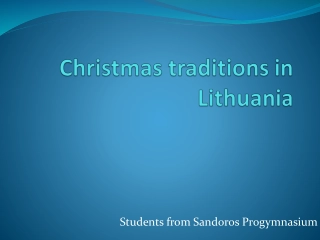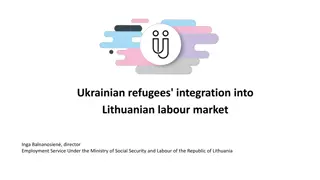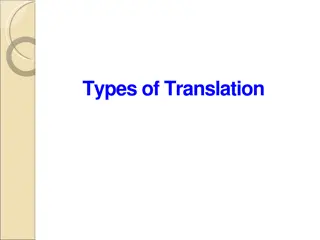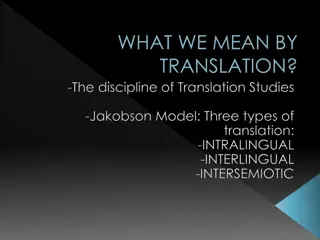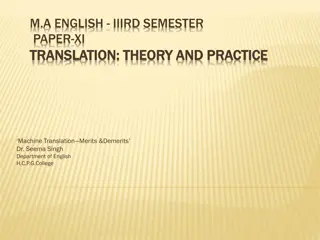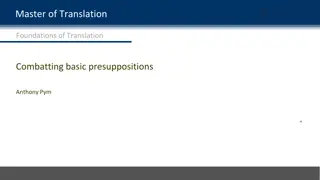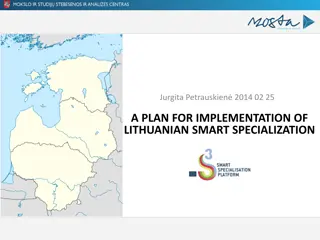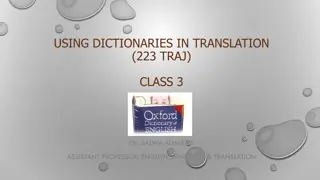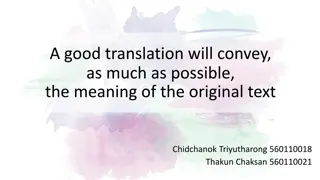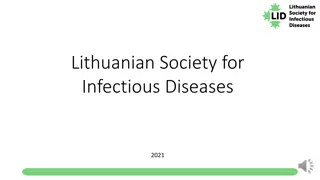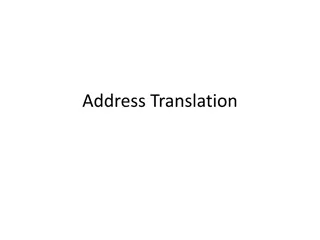A Resource for Collocation Teaching, Learning, and Translation in Lithuanian
This resource focuses on collocations in Lithuanian, covering topics such as identification and selection of collocations, cross-cultural language variation, translation issues, and available language resources and tools. It offers materials for language teaching, translation studies, and linguistics, with applications in secondary and higher education. The content integrates CLARIN infrastructure and provides links to Lithuanian language resources for self-study and research purposes.
Download Presentation

Please find below an Image/Link to download the presentation.
The content on the website is provided AS IS for your information and personal use only. It may not be sold, licensed, or shared on other websites without obtaining consent from the author.If you encounter any issues during the download, it is possible that the publisher has removed the file from their server.
You are allowed to download the files provided on this website for personal or commercial use, subject to the condition that they are used lawfully. All files are the property of their respective owners.
The content on the website is provided AS IS for your information and personal use only. It may not be sold, licensed, or shared on other websites without obtaining consent from the author.
E N D
Presentation Transcript
A Resource for Collocation Teaching, Learning, and Translation Jurgita Vai enonien Jolanta Kovalevskait Erika Rimkut
Developed materials: Resource book: https://arka.pastovu.vdu.lt/wp- content/uploads/2022/07/Mokomoji-priemone.pdf Accompanying website: https://resursai.pastovu.vdu.lt/mokomoji- priemone/apie
Objectives and topics The resource contributes to the teaching, learning, and translation of collocations in Lithuanian. Topics discussed: Chapter 1: collocations vs. multiword units; identification/ selection of collocations for language learning purposes; tools and resources for collocation description and analysis; collocation structure, use, and variation. Chapter 2: cross-cultural language variation and equivalence; collocations as a unit of translation; collocation related translation problems; freely available language resources and tools for collocation translation and research.
Applications Study fields: Language teaching and learning (secondary and higher education) Translation studies Linguistics Use: Integration of the relevant chapters/ exercises into curriculum/ lectures Inspiration for exercise adaptation and their extension to other language pairs Self-study <...>
CLARIN content References to the CLARIN infrastructure and language resources (e.g.,VLO, Resource Families); Self-study activities which include the use of resources and tools offered by CLARIN (Example 1); Application of the Lithuanian language resources available via CLARIN-LT repository: exercises developed or data extracted for students to use (Example 2); learners are encouraged to go to repository/ databases to perform activities or check the answers (Example 3).
Integrated Lithuanian language resources and tools stored at CLARIN-LT repository Colloc -- A Tool for Automatic Identification of Multiword Expressions. http://hdl.handle.net/20.500.11821/32. Corpus of the Contemporary Lithuanian Language. http://hdl.handle.net/20.500.11821/16. DELFI.lt corpus. http://hdl.handle.net/20.500.11821/30. ORVELIT v3. http://hdl.handle.net/20.500.11821/40. The Database of Lithuanian Multiword Expressions. http://hdl.handle.net/20.500.11821/49.
Study outcomes The readers will: gain knowledge about and be able to use open access resources important for collocation teaching, learning, and translation; know how to develop collocation learning/ teaching competence individually; apply various methods for cross-cultural comparison and translation of collocations.
Example 1: Task 4.9 Application of e-resources for metaphorical collocation translation: Get acquainted with the resources listed in this chapter that can help you translate metaphorical collocations. Choose one resource and present it in more detail. Discuss the advantages and disadvantages of the resource as a reference source in metaphor translation. Select 10 collocations from the PASTOVU database and describe their translation process (LT-EN). Make a list of collocation databases, dictionaries, or other resources not mentioned in the chapter. Develop translation procedure of metaphorical collocations that you find the most efficient. Present your project in class.
Example 2: Task 3.11 Find the collocates of the abstract nouns heart, hope, and idea in original and translated popular science texts (source: ORVELIT corpus). Note that it will be easier to compare the data if you remove noise from the concordance lines. Do the collocates of the abstract nouns differ in original Lithuanian texts and those translated from English? Can the differences be induced by English language interference or may be a result of the content differences of original and translated data? How could your statements be supported? Notes: To analyse other words or genres, you can download the corpus from the CLARIN-LT repository. If you use AntConc software to analyze the data, you may watch this tutorial (link for download). If you do not have a lot of time for the task, you may analyse the first 50 or 100 occurrences. Data (access: https://resursai.pastovu.vdu.lt/atsisiusti#konkordansai): IDEA_original pop sci.txt IDEA_translated pop sci.txt HEART_ original pop sci.txt HEART_ translated pop sci.txt HOPE_ original pop sci.txt HOPE_ translated pop sci.txt
Translated fiction (EN-LT) (approx. 1 mln. tokens); node: hope (nom.); raw hits: 31 Original Lithuanian fiction (approx 1 mln. tokens); raw hits: 69
Example 3: Task 3.12 Choose a text and its translation (e.g. news portals in different languages, your own translations, etc.). Upload the original text or website link to Voyant Tools text analysis and visualization software and explore different data visualization functions: Cirrus, Links, TermsBerry. Do the same with the translation of the text. Compare the diagrams for the selected collocations and discuss the similarities and differences between the collocates of selected words in original and translated texts. Software: https://voyant-tools.org/ Instructions: https://voyant-tools.org/docs/#!/guide/start Data suggestions: National Geographic Magazine (EN / LT) Websites of shops, companies, universities, government organizations (LT / EN)
ST and TT comparison Source: Gyvas atod sis. Lietuvi poezijos vertimai. Breathing Free. Poems from the Lithuanian. Editor and Translator: V. Bakaitis. 2001. Vilnius: LRLS. Rugiag l s (Kazys Binkis) Cornflowers Vien tik m lyna akyse, em j, ore ir danguj Daugiau nieko nebmatysi, Vien tik m lyna akyse... U simerksi, pam stysi, Nusijuoksi... O paskui Vien tik m lyna akyse, em j, ore ir danguj. Blue is all there is to see: Earth, air and sky; With nothing more before your eyes, Blue is all there is to see, Squint both eyes shut and think, You'll have to laugh for, all the while, Blue is all there is to see: Earth, air and sky.
Summing up Hopefully, the presented resources: will be used as open access educational materials for the lesser- used Lithuanian language; encourage the readers to use, adapt, and further develop the exercises for different language pairs and educational needs; promote the use of the mono- and multilingual corpora for translation and language learning purposes.


